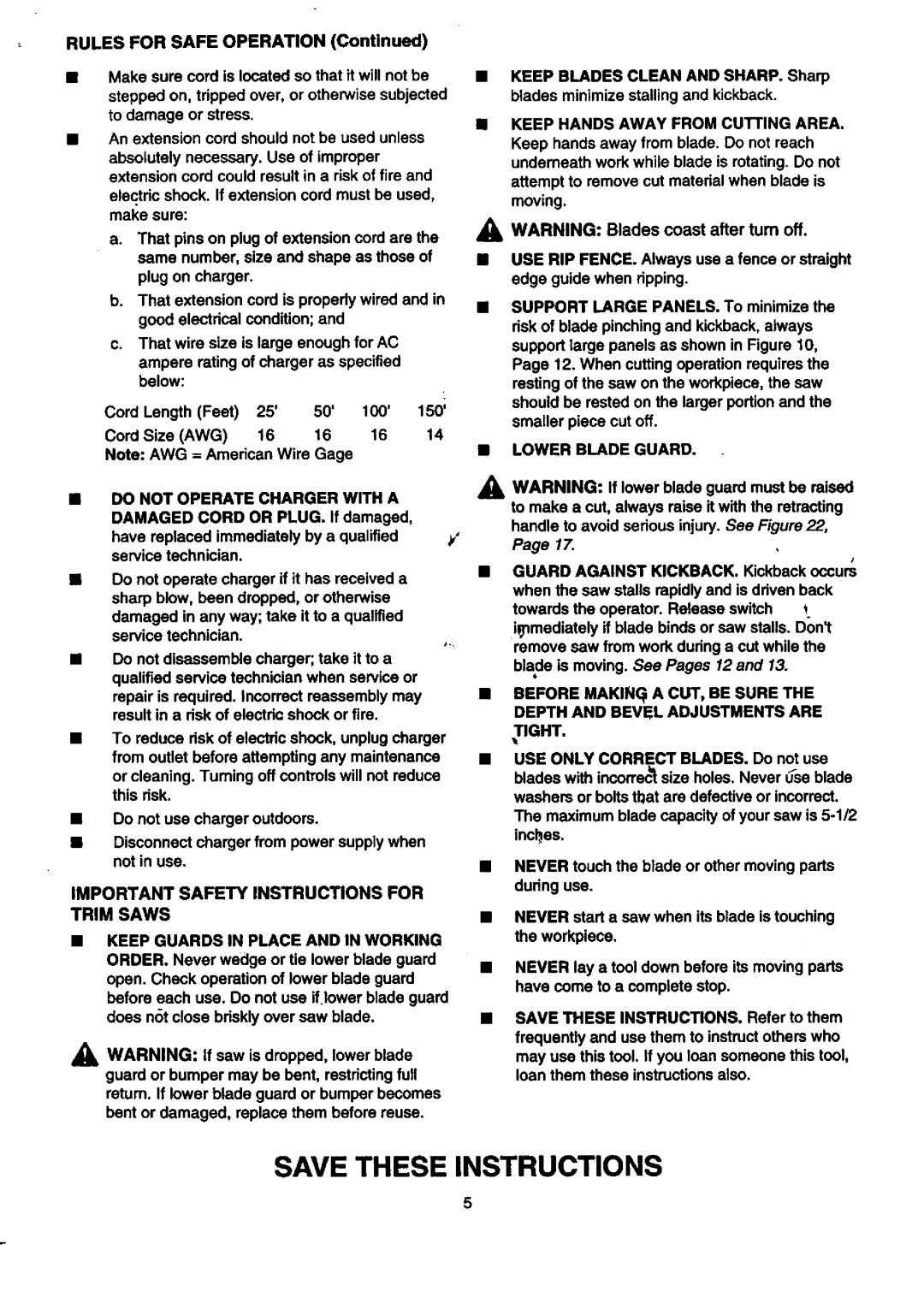
RULES FOR SAFE OPERATION (Continued)
mMake sure cord is located so that it will not be stepped on, tripped over, or otherwise subjected to damage or stress.
An extension cord should not be used unless
absolutely necessary. Use of improper extension cord could result in a risk of fire and
electric shock. If extension cord must be used, make sure:
a.That pins on plug of extension cord are the same number, size and shape as those of plug on charger.
b.That extension cord is properly wired and in good electdcal condition; and
c.That wire size is large enough for AC ampere rating of charger as specified below:
Cord Length (Feet) 25' 50' 100' 150'
Cord Size (AWG) 16 16 16 14 Note: AWG = American Wire Gage
MDO NOT OPERATE CHARGER WITH A DAMAGED CORD OR PLUG. If damaged, have replaced immediately by a qualified service technician.
mDo not operate charger if it has received a sharp blow, been dropped, or otherwise
damaged in any way; take it to a qualified service technician.
Do not disassemble charger; take it to a qualified service technician when service or repair is required. Incorrect reassambly may result in a dsk of electdc shock or fire.
To reduce dsk of electdc shock, unplug charger from outlet before attempting any maintenance or cleaning. Turning off controls will not reduce this dsk.
nDo not use charger outdoors.
•Disconnect charger from power supply when not in use.
IMPORTANT SAFETY INSTRUCTIONS FOR TRIM SAWS
KEEP GUARDS IN PLACE AND IN WORKING
ORDER. Never wedge or tie lower blade guard open. Check operation of lower blade guard before each use. Do not usa if,lower blade guard does not close bdskly over saw blade.
&WARNING: If saw is dropped, lower blade guard or bumper may be bent, restricting full return. If lower blade guard or bumper becomes bent or damaged, replace them before rouse.
•KEEP BLADES CLEAN AND SHARP. Sharp blades minimize stalling and kickback.
•KEEP HANDS AWAY FROM CUTI'ING AREA.
Keep hands away from blade. Do not reach undemeath work while blade is rotating. Do not attempt to remove cut matedal when blade is moving.
WARNING: Blades coast after tum off.
•USE RIP FENCE. Always use a fence or straight edge guide when dpping.
SUPPORT LARGE PANELS. To minimize the dsk of blade pinching and kickback, always support large panels as shown in Figure 10, Page 12. When cutting operation requires the resting of the saw on the workpiece, the saw should be rested on the larger portion and the smaller piece cut off.
•LOWER BLADE GUARD.
,_ WARNING: If lower blade guard must be raised to make a cut, always raise it with the retracting handle to avoid serious injury. See Figure 22,
Page 17.
/
GUARD AGAINST KICKBACK. Kickback occurs when the saw stalls rapidly and is ddven back towards the operator. Release switch bpmediataly if blade binds or saw stalls. Don_ remove saw from work dudng a cut while the blade is moving. See Pages 12 and 13.
mBEFORE MAKIN_ A CUT, BE SURE THE DEPTH AND BEVEL ADJUSTMENTS ARE TIGHT.
USE ONLY CORRECT BLADES. Do not use blades with incorrec_size holes. Never u_seblade
washers or bolts that are defective or incorrect. The maximum blade capacity of your saw is
•NEVER touch the blade or other moving parts during use.
•NEVER start a saw when its blade is touching the workpiece.
•NEVER lay a tool down before its moving parts have come to a complete stop.
SAVE THESE INSTRUCTIONS. Refer to them frequently and use them to instruct others who may use this tool. If you loan someone this tool, loan them these instructions also.
SAVE THESE INSTRUCTIONS
5
